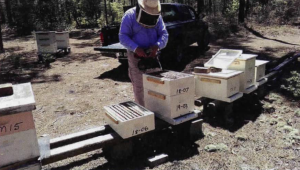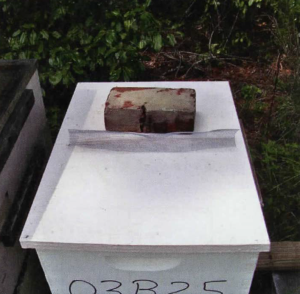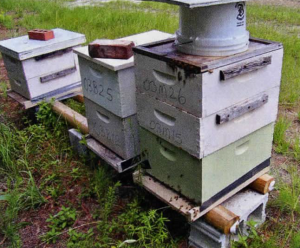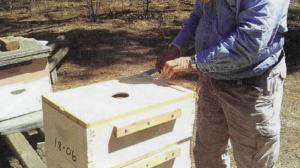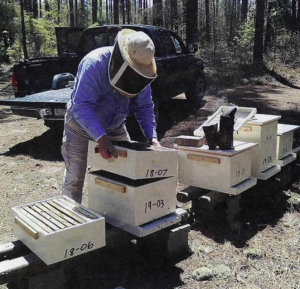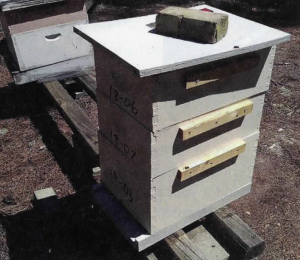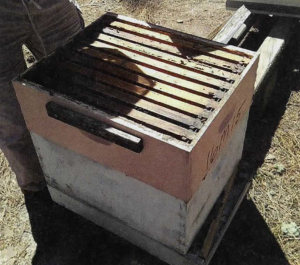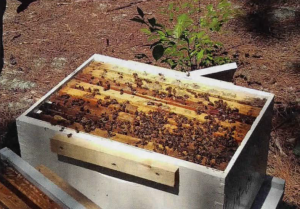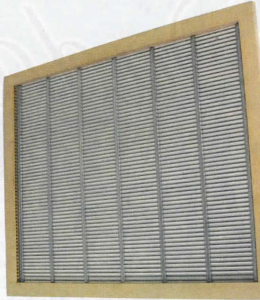By: David E. MacFawn
This article originally appeared in the Winter 2019 issue of BEEKeeping Your First Three Years
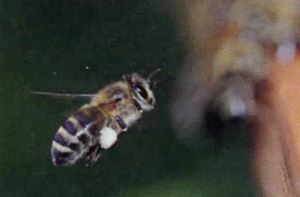 Selecting hive equipment is extremely important. While woodenware is expensive, it will last a very long time if maintained properly. The full weights of the various depth hive bodies should be considered when selecting equipment for ease of lifting and handling. While other bee equipment should be examined, Langstroth equipment has been around a long time with a lot of issues being resolved.
Selecting hive equipment is extremely important. While woodenware is expensive, it will last a very long time if maintained properly. The full weights of the various depth hive bodies should be considered when selecting equipment for ease of lifting and handling. While other bee equipment should be examined, Langstroth equipment has been around a long time with a lot of issues being resolved.
The ¾” board thickness of the boxes should have two coats of paint maximum since a thick coat of paint will chip when using a hive tool to separate boxes. While I put a primer coat and one coat of paint on the frame rest rabbit, recently I have started coating the ¾” board thickness with just one coat of high-quality paint. The paint needs to be allowed to dry thoroughly prior to stacking the hive bodies to keep the paint on the ¾” thickness from peeling off. Woodenware will rot where the hive tool is inserted between boxes and wears off the paint. Hence, you want to rotate your boxes so you are not always inserting your hive tool at the same place. The outside of the box should have two to three coats of paint. The inside of the box should not be painted since the bees will coat the inside with propolis.
I historically have used mis-mixed paint but found I could not get the high-quality paint. A high-quality paint will last much longer between equipment refurbishments and is worth the extra money when you consider your time invested in painting. New equipment needs a coat of primer and two coats of high-quality latex paint, either sprayed or brushed. High-quality paint typically has a high ash count.
Adding cleats above hand-holds increases the surface lifting area. The cleats are made out of ¾” thick x 2″ wide 8-or 10-foot strips cut into about 1-foot lengths attached with three 1 ¼” deck screws. Sometimes I paint the cleats and sometimes I do not. The cleats will last over ten years without painting. Cleats are useful for lifting but do interfere with stacking hives in a pickup truck, although minimally.
Solid bottom boards / Screened bottom boards
In the hot southeast screened bottom boards are beneficial for air flow, especially when moving the hive. However, a moving screen on top of the hive in place of the inner/outer cover works just as well. When moving a hive, number 8 hardware cloth is cut to the bottom board entrance width, folded over, and inserted into the entrance. Solid bottom boards are useful in the Spring to retain heat when splitting. I re-read the research on screened bottom boards. While there was a small and largely consistent reduction in mite numbers, it was not statistically significant. During warm weather, moving screens on top of the hive in place of an inner/outer cover is recommended. Bees generate a lot of heat and can smother quickly.
Note in Figure 1 how the hives are facing out in a semicircle so the bees are not flying into you. I can drive my truck up to the back of the hives for easy loading and unloading of equipment and working the hives. Three cement blocks with two landscape timbers on it for a hive stand is about the correct height to work a hive, and you also can get a large wheeled hand-truck tongue under the hive to allow one person to move the hive.
Woodenware is expensive; as long as it is structurally sound, duct tape can be used to seal holes. I still use beeswax crimp wired foundation in my brood chamber since it is easy for the bees to pull out the comb and it is less expensive than plastic foundation, and beeswax coated plastic foundation in my honey supers since they withstand extracting better than beeswax foundation. I burn my beeswax brood frames upon rotation for disease control. If the beeswax in brood frames is rendered, you get minimal wax from the comb.
- Dr. Tom Seeley in November 2006 American Bee Journal, pp 955-957 Volume 146 No. 11 discussed how Beeswax foundation results in higher beeswax production and higher hive weight gain/honey production. Since 2006 we have learned to coat plastic foundation with two to three coats of beeswax. The bees use this beeswax coating to assist in pulling out the comb. Seeley also found wood frames had better results than plastic frames.1
It should be noted that frame spacers should not be used when initially drawing out plastic foundation frames. The bees will bridge comb between the frames when nine frame spacers are initially used in a ten frame super. The festooning (drawing out of beeswax comb) temperature is around 97° Fahrenheit, which means the bees need to maintain the 97°F for a plastic foundation to be successful. When old or damaged by wax moths, I burn the crimp wire deep brood chamber frames for disease control.
A hive consists of:
-
-
-
- A bottom board. This may be screened or solid. There are benefits and detriments of each.
- A brood chamber
- Optional queen excluder
- A super on top of the deep box
- • Shallow
- • Medium
- • Deep
- An inner cover, especially if you are going to use a telescoping cover. Without an inner cover is it virtually impossible to remove a telescoping cover due to propolis.
- A top or outside cover. This may be a telescoping cover, migratory cover, or cover made out of OSB like Advantech™. I do not recommend an entire hive to be made out of Advantech™ due to the weight and the Advantech™ OSB not being able to “breathe” like normal wood.
-
-
Below are typical full super weights:
You need to decide how much weight you can handle and select the appropriate size equipment.
Note several items in Figure 3. The hive on the end consists of a bottom board, deep brood chamber, two medium supers, an inner cover with a pail feeder on top and an outer cover. If moving hives, high-quality duct tape is used in place of hive staples. In the high moisture southeast, the woodenware will rot where the hive staples are driven. Also, note the cement block with two landscape timbers stands. This allows a large wheel hand truck to move the hives by one person. A trailer with a loading gate allows the hives to be loaded with a hand truck without lifting by hand. A super is defined as any box above the brood chamber. It can be shallow (5 11 /16″), a medium (6 5/8″) or a deep (9 5/8″).
When purchasing equipment, you want to make sure the space between two supers/boxes meets the bee space requirements (¼” to 3/8″). The bees will glue the space with propolis if less than ¼” and build burr comb in the space if greater than%”. The outside dimensions of the boxes are not as critical but somewhat unsightly if they do not line up.
The super sizes/depths should be standardized as much as possible. The super-size should be matched to your nectar flow and honey requirements for any dearths’ and/ or overwintering. The last thing you need is to only have shallow frames when you need a medium frame. I have standardized on a deep brood chamber, and medium hive bodies for my feed chamber and honey supers. This configuration works well in the Columbia, South Carolina area.
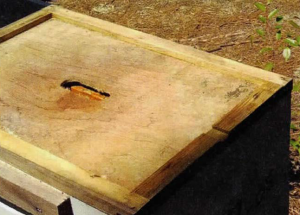
Figure 4: Ten frame inner cover. Note the rim notch to allow moisture to escape. Note the porter bee escape oval hole.
In recent years, I have switched from ten frame hives to eight frame hives due to:
The eight-frame hive being lighter and easier to move. Yes, I am getting older.
Dr. Tom Seeley has determined in the wild most colonies are five to eight combs. I suspect this is why in a ten-frame hive, it takes work to get the bees to draw out and work the outer frames sometimes.
Smaller nest size enhances natural swarming and results in a natural brood break. Eight frame hives do take more management time to work the hive to reduce increased swarming.
Queen Excluders:
Some beekeepers use queen excluders and some do not. A queen excluder keeps the queen from laying above the excluder keeping brood out of honey supers.
Bees will not normally draw foundation above a queen excluder. Bait the super above the excluder with drawn comb; either an entire super (best) or use two to three frames of foundation interspaced with drawn comb in an eight or ten frame super. A band of honey can also serve as an excluder for a queen.
Woodenware will last a long time if properly maintained. There is a trade off between eight frames and ten frame equipment. Langstroth equipment is standard and easy to use for honey production and pollination. When purchasing equipment from different manufacturers, you want to make sure the bee space (¼” to 3/8″) between boxes is not violated. A hand-truck with large wheels can be used for one person to move hives if the hive stands are set up properly. While the beekeeper works “boxes” with Langstroth hives, they are standard and the issues have been worked out over almost one hundred and seventy years.
David MacFawn is a Master Craftsman beekeeper living in the Columbia, South Carolina area.
1Seeley, T 2006, “Plastic Comb Foundation Can Hinder Comb Building and Honey Production,” American Bee Journal, Volume 146 No.11 pp 955-957.







